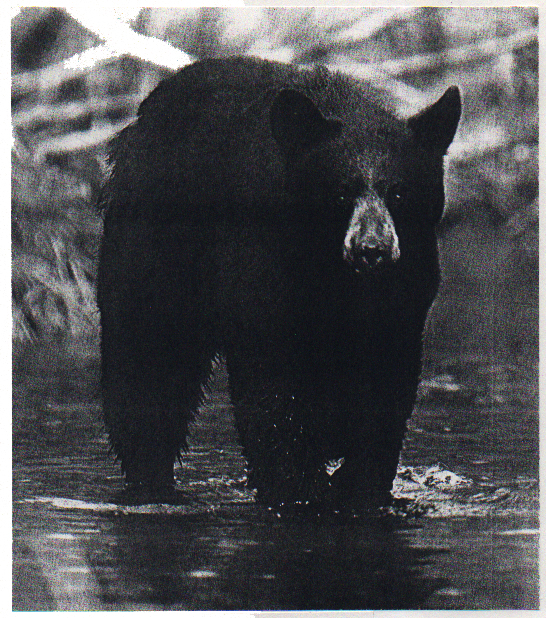 Marshall
Cultural Atlas Marshall
Cultural Atlas
This collection of student work is from
Frank Keim's classes. He has wanted to share these works for others
to use as an example of Culturally-based curriculum and documentation. These
documents have been OCR-scanned. These are available
for educational use only.

Black Bears
|
Black Bears
|

|
American Black bears are the most widespread and numerous bears in
North America. They inhabit most of the continent's forested areas
beginning at the northern tree limit of the Arctic, south throughout
much of the United States and down the wooded Sierra Madre Mountains
into northern Mexico. East and West they range from Newfoundland to
British Columbia's Queen Charlotte Islands.
Black bears are small bears compared to their cousins the Brown
and Polar bear. They usually weigh no more than 300 pounds and are
less than 5.5 feet long. They have long straight noses and the
largest ears of all the bears.
Trees are a Black bear's best friends. When ever they are in
danger Black bears climb trees. They have rather short claws that are
ideal for scrambling up a tree trunk. It is not surprising that Black
bears stay as close to trees as they can. They rarely leave the
forest.

Black bears like to eat berries, leaves, and fish. They will steal
fish from smoke houses when people are not around the camp or if they
are sleeping. Sometimes you could see them eating berries on the
tundra when it is time for them to fatten up for winter.
Black bears have only two babies during the winter. They grow up
in their cave till spring comes. There they will feed on their
mother's milk until they are able to take care of themselves outside
of the cave.

After leaving the den in spring, the mother bear will teach the
cubs to run away from danger and how to hunt for fish in the rivers.
She will also teach them how to eat good food like fish, roots, black
berries, blue berries and salmon berries.
The mother will keep the cubs till they are about 2 years of age.
Then the mother will kick them out of their lives. Then they will
have to learn how to live on their own. That will be hard to do
because they are still young. But they will have to learn how to live
alone and be smart so they can tell what is dangerous and what is
not. Even so some of them will be shot the first year they are
alone.
Although Black bears are smart animals their young are curious and
dumb. Sometimes they go to your tent and eat your food or bother you
in the night when you are sleeping. This is when they get into
trouble and may be shot and killed.
The present status of the Black bear is good. The population is
way up right now. But I think it will go down because there are a lot
of hunters in the world. Like me, I will still hunt them for their
meat.
|
THE END!!
|

|
Henry S. Hunter
Bear Fire
Stories and Poems
about Bears
|
by Marshall High School
Language Arts Classes
Spring, 1992
Produced
by
Information
about Bears
Creative
Stories from the Imagination
True
Stories from Experience
Poems
Christmastime Tales
Stories real and imaginary about Christmas, Slavik, and the New Year
Winter, 1996 |
Christmastime Tales II
Stories about Christmas, Slavik, and the New Year
Winter, 1998 |
Christmastime Tales III
Stories about Christmas, Slavik, and the New Year
Winter, 2000 |
| Summer Time Tails 1992 |
Summertime Tails II 1993 |
Summertime Tails III |
| Summertime Tails IV Fall, 1995 |
Summertime Tails V Fall, 1996 |
Summertime Tails VI Fall, 1997 |
| Summertime Tails VII Fall, 1999 |
Signs of the Times November 1996 |
Creative Stories From Creative Imaginations |
| Mustang Mind Manglers - Stories of the Far Out,
the Frightening and the Fantastic 1993 |
Yupik Gourmet - A Book of
Recipes |
|
| M&M Monthly |
|
|
| Happy Moose Hunting! September Edition 1997 |
Happy Easter! March/April 1998 |
Merry Christmas December Edition 1997 |
| Happy Valentine’s
Day! February Edition
1998 |
Happy Easter! March/April Edition 2000 |
Happy Thanksgiving Nov. Edition, 1997 |
| Happy Halloween October 1997 Edition |
Edible and Useful Plants of Scammon
Bay |
Edible Plants of Hooper Bay 1981 |
| The Flowers of Scammon Bay Alaska |
Poems of Hooper Bay |
Scammon Bay (Upward Bound Students) |
| Family Trees and the Buzzy Lord |
It takes a Village - A guide for parents May 1997 |
People in Our Community |
| Buildings and Personalities of
Marshall |
Marshall Village PROFILE |
Qigeckalleq Pellullermeng ‘A
Glimpse of the Past’ |
| Raven’s
Stories Spring 1995 |
Bird Stories from Scammon Bay |
The Sea Around Us |
| Ellamyua - The Great Weather - Stories about the
Weather Spring 1996 |
Moose Fire - Stories and Poems about Moose November,
1998 |
Bears Bees and Bald Eagles Winter 1992-1993 |
| Fish Fire and Water - Stories about fish, global warming
and the future November, 1997 |
Wolf Fire - Stories and Poems about Wolves |
Bear Fire - Stories and Poems about Bears Spring,
1992 |
|